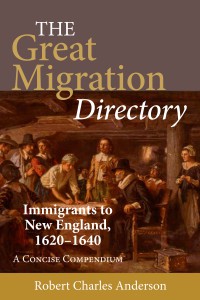 On the first day of 2016, Vita Brevis can boast 780,157 page views over the life of the blog. With dozens of voices writing for the blog, I hope that readers will check back often to see what’s new at Vita Brevis. Following yesterday’s blog post, here follows a snapshot of the second six months of 2015 at the blog.
On the first day of 2016, Vita Brevis can boast 780,157 page views over the life of the blog. With dozens of voices writing for the blog, I hope that readers will check back often to see what’s new at Vita Brevis. Following yesterday’s blog post, here follows a snapshot of the second six months of 2015 at the blog.
Robert Charles Anderson’s post on the new Great Migration Directory was published on 1 July:
The Great Migration Directory attempts to include all those who immigrated to New England during the Great Migration, and only those immigrants. After much examination of the historical record, and particularly of the activities of the passenger vessels each spring, I determined that the Great Migration ended during 1640, and so this volume is designed to include every head of household or unattached individual who arrived between 1620 and 1640.
This basic conclusion must be tempered by two other considerations, which have always guided the Great Migration Study Project. First, because published errors are immortal, an error of omission is always preferable to an error of commission. If someone who was not a Great Migration immigrant is included in this volume, that mistaken conclusion will live forever on library shelves. If, on the other hand, a demonstrable Great Migration immigrant is omitted from this volume, he or she can always be added to the list. Thus, when deciding whether or not to include a given immigrant in this volume, I have always taken a conservative approach…
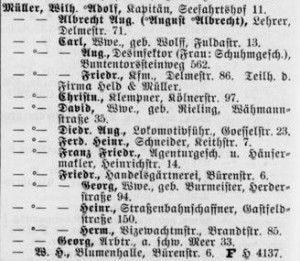 In her post on 18 August, Anna Todd offered a primer on a digital German research resource:
In her post on 18 August, Anna Todd offered a primer on a digital German research resource:
While searching for online records for Bremen, Germany, I came across a digitized collection of Bremen address books spanning the period 1794–1955 with the help of the website German Roots. The Bremer Adressbücher 1794-1955 (Bremen Address Directories) database has been digitized by the State and University Library of Bremen, and can provide a wealth of information about your Bremen ancestors that might not be found in American records.
These directories can be browsed by surname and street number, like the city directories published for Massachusetts. The website and the directories are both in German, but you can use the Google page translator function on your browser or simply open a second tab to Google Translate for words that you need help deciphering. Once you begin attempting to translate the actual record, it can be helpful to keep handy a chart of German letters and common abbreviations...
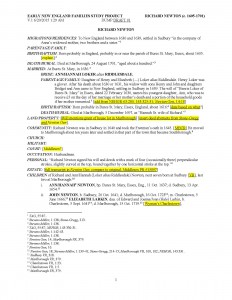 Alicia Crane Williams has written several series on genealogical research techniques as well as guides to as variety of record types. On 29 September she gathered up several different posts on her research process, to make them available in one spot:
Alicia Crane Williams has written several series on genealogical research techniques as well as guides to as variety of record types. On 29 September she gathered up several different posts on her research process, to make them available in one spot:
From Collecting published accounts:
This may turn out like watching sausage being made or paint dry, but let’s walk through the process of creating an Early New England Families Study Project entry.
We start with the entry from Torrey’s New England Marriages Prior to 1700:
NEWTON, Richard (–1701) & Anne/Hannah? [LOKER/RIDDLESDALE] (ca 1616–1697); by 1641; Sudbury {Stevens-Miller 132, 138, 143; Marston-Weaver 47; Warner-Harrington 414, 471; Reg. 49:341; Bullard Anc. 153; Chaffee (1911) 134; Holman Ms: Loker 3; Moore Anc. 399; Framingham Hist. 340, 342?; Marlboro Hist. 421; Bent Anc. 27; Newton (#4) 17-18; Bigelow-Howe 94; Leonard (#2) 49; Cutler 2:5; Morris-Flynt 56; Tingley-Meyers 92}
My first step is to locate as many of these sources as possible and begin a comparative analysis of what has already been published. I use the 2011 edition of Torrey’s Marriages, which gives the bibliography or Source List in Volume 3, pages 1739–1830…
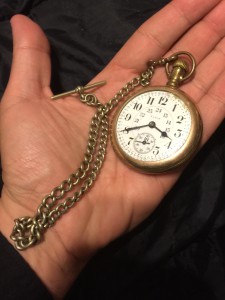 On 21 October, David Allen Lambert told the story of a prized family possession, his great-grandfather’s pocket watch, the gift of some distant kinsmen:
On 21 October, David Allen Lambert told the story of a prized family possession, his great-grandfather’s pocket watch, the gift of some distant kinsmen:
To the people of Amherst, Nova Scotia, [Thomas William Clark] was known as “Wildcat” Tom Clark for the speed in which he drove the locomotive. The Library and Archive of Canada have partial employment records for Canadian Railway Employees online. The file cards relating to my great-grandfather detail his days as an employee from 1898 until his retirement on 30 September 1941. Sadly, the original case files for these employees were destroyed…
Thomas’s second wife Ada worked as a waitress at the Amherst Hotel. He married her at the home of the officiating minister at 32 Rupert Street in Amherst on 2 September 1924. Ada’s family remembers him fondly, telling of going fishing with a friendly and loving uncle…
Sometime before her death she passed along one of the keepsakes from her late husband to her brother Arthur Halliday. Before his death this same keepsake was passed along to his son Raymond Halliday. During my visit [to the Halliday family in Nova Scotia], I told Raymond’s sister and brother-in-law that I had no photo of my great-grandfather and asked that they let me know if they ever found one. A couple of weeks ago I got a letter telling me they wanted to give me something that belonged to the man I never knew. A name that I had researched since childhood, without a face, without a gravestone, would now become real to me.
Shortly after the letter arrived I received a small package wrapped in cloth. For once in my life I held something that actually belonged to a man who was previously just a name on a chart, the subject of family stories. The gold railroad engineer’s watch ticked once again after being wound for the first time in years. To hear the ticking of a sound familiar to my great-grandfather’s ears made me pause. Where would this watch, this heirloom, go after I am gone?
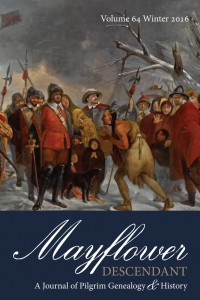 Leslie Ann Weston reported on the first issue of the new Mayflower Descendant (edited by Chris Child and published by the New England Historic Genealogical Society) on 26 November:
Leslie Ann Weston reported on the first issue of the new Mayflower Descendant (edited by Chris Child and published by the New England Historic Genealogical Society) on 26 November:
With Chris and the editorial board taking the publication in something of a different direction from years past – broadening the scope to include more history on the towns in which Mayflower descendants lived and a wider range of families treated – we thought we’d offer a preview of the articles that will appear in the Winter 2016 issue:
- A reprint of Robert Charles Anderson’s town study of Scituate, Massachusetts, the third town organized under the Plymouth Colony;
- A reprint of Bowman’s article addressing the inventory of Samual2 Eaton (Francis1), who arrived on the Mayflower as an infant, and the settlement of his estate;
- A new article from Christopher Carter Lee that shows how poetry chronicled John Alden’s descendants in New York City;
- Marian Natale’s new article on Solomon Cushman’s first wife, Ruth, whose parentage is not known but is explored here;
- Child’s first installment of a series of articles on the Orcutt Family of Weymouth, Massachusetts, following William1 Orcutt and descendants for three generations;
- An article by Caleb H. Johnson (previous editor of the Descendant) and Simon Neal on Mayflower-related documents in the records of the Court of the King’s Bench in London;
- David Allen Lambert concludes his transcription of the vital records of Easton, Massachusetts;
- Gary Boyd Roberts and Julie Helen Otto explore notable Mayflowerdescendants, focusing in this issue on Horatio Alger and Willis Haviland Carrier; and
- Child offers a roundup of Mayflower-related genealogy published elsewhere in 2014.
 And on 10 December, Lindsay Fulton wrote of the way a genealogical research discovery provided a fresh link between family members:
And on 10 December, Lindsay Fulton wrote of the way a genealogical research discovery provided a fresh link between family members:
Mine is a typical American family, and I am a typical genealogist. My family is an assortment of divorced households and second marriages and I, the ever diligent genealogist, have labored to research all of the family lines, even if they are not my own, because even when I don’t share their DNA, they are my family.
Like members of my immediate family, my blended family can be uninterested in the details of their own genealogy. Don’t get me wrong: they like the highlights (your great-grandparents were from County Cork or your ancestors were Loyalists who moved to Quebec), but not the mundane. So sometimes I struggle to get my family interested, whether they are my blood relatives or part of my blended family.
Thus, when I began the genealogies of my sister-in-law, my (undoubtedly) future sister-in-law, step-brother, and step-mother, I was secretly looking for something that would get them excited. And not just the usual highlights, but a small detail that would make them connect on a personal level with a family member. Because it is important, and it’s why my job is so rewarding: I help people reconnect with their ancestors; I help them connect with people they never knew.
And happily, after researching several lines of my extended family, I finally found it… [Read the rest of her post to find out what happened next!]
These twelve posts represent only about five percent of the total published at Vita Brevis in 2015, so I hope the readers of today’s post will start 2016 by subscribing to the blog so as not to miss a single post on genealogical research, news, and results!
Share this:
About Scott C. Steward
Scott C. Steward has been NEHGS’ Editor-in-Chief since 2013. He is the author, co-author, or editor of genealogies of the Ayer, Le Roy, Lowell, Saltonstall, Thorndike, and Winthrop families. His articles have appeared in The New England Historical and Genealogical Register, NEXUS, New England Ancestors, American Ancestors, and The Pennsylvania Genealogical Magazine, and he has written book reviews for the Register, The New York Genealogical and Biographical Record, and the National Genealogical Society Quarterly.View all posts by Scott C. Steward →